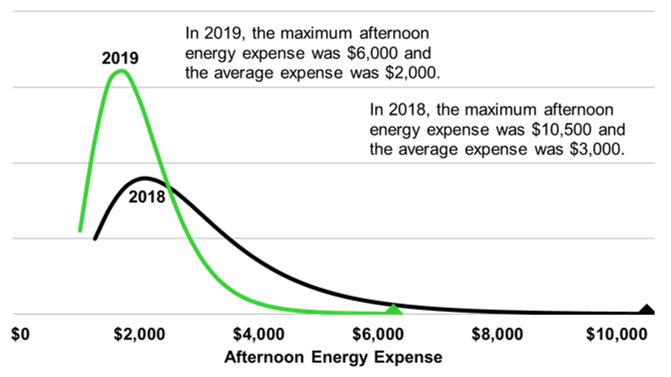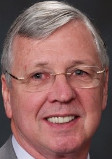Demonstration of Effective Building-Grid Integration
By William Hederman and Vince Cushing
The U.S. Department of Energy's Office of Energy Efficiency and Renewable Energy (EERE) has taken important steps forward from the long-standing "grid modernization" policy in the last few years. Specifically, EERE is pursuing a grid-interactive efficient building initiative. Building-grid integration can enhance the grid resilience, efficiency, and other desired network characteristics. At the IEEE PES ISGT conference in Washington, DC in February 2020, there were reports on actual accomplishments from such integration. This technical note summarizes the important progress of one such project.
Notable performance was reported for a technology coined as Buildings as Batteries®, which was deployed for the 2019 cooling season in a prominent commercial office building in midtown Manhattan. The technology uses EnergyPlus, a sophisticated building energy modeling platform developed by EERE’s Building Technology Office. EERE’s Solar Energy Technology Office is now funding a pioneering Manhattan pilot to demonstrate a portfolio version of the technology that coordinates multiple buildings with PV for greater grid benefit.
THE BUILDING: The host building is the Manhattan global headquarters of one of the world's foremost financial institutions, a large building at more than one million square feet. The building is LEED Gold certified, and its heating, ventilation and air conditioning (HVAC) system and operations are highly sophisticated.
Acceptance of the Software as a Service (SaaS) technology innovation required a strict vetting to assure the host that it met the Financial Services Information Sharing and Analysis Center (FS-ISAC) cybersecurity standards.
THE INNOVATION: Buildings as Batteries elegantly combines technical insights from power grid electrical engineering, commercial building energy modeling and mechanical engineering controls, and utility rate design analysis. These Insights expand the usefulness of building concrete and drywall (i.e. its thermal mass) as a free and universally available energy storage medium. Storage enables highly efficient cooling at low electricity prices pre-occupancy that, in turn, displaces less efficient cooling at high electricity prices on hot summer afternoons. In effect, the technology arbitrages both chiller efficiency curves and day/night electric prices.
The electrical system signals the building through hourly electric prices (by the New York Independent System Operator or NYISO), demand charges (by both Con Edison and NYISO), and demand response event notifications (from both Con Edison and NYISO).
THE TECHNOLOGY: QCoefficient’s EMeister is a cloud-based software platform that uses patented algorithms to optimize the operation of a host building HVAC by sending hourly comfort temperature settings. The application executes through the building’s already existing building automation system and takes a few man-weeks to integrate. Optimization is quite flexible – user selectable to minimize the building’s electric bill or maximize the grid efficiency or optimize a combination of financial, energy and environmental metrics.
THE RESULTS: Buildings as Batteries reduced HVAC energy use by 20 percent (see Figure 1), HVAC peak demand by 30 percent, and total building afternoon energy expense by 33 percent (see Figure 2) for the 2019 cooling season.

Figure 1 Reduced HVAC Cooling Season Energy

Figure 2 Reduced Cooling Season Expense and Financial Risk
For an initial operating expense investment in the tens of thousands of dollars for customization and integration with the building automation system, the building saved hundreds of thousands of dollars in the first cooling season. The savings were achieved with no additional costs for building engineering and with no effect on the comfort of the tenants.
NEXT STEPS: The same building management company and other building owners, operators, and service companies are deploying the technology in several million square feet of NYC buildings in 2020. In part, the interest is driven by concerns about compliance with the new carbon emission limits set by Local Law 97 that was passed in the Spring 2019. Expansion in Chicago and Atlanta also appears likely in the 2020-21 timeframe.
ADDITIONAL INFORMATION:
Vincent Cushing, vince.cushing@qcoefficient.com
W Hederman, hederman@upenn.edu
Also see: www.qcoefficient.com
For a downloadable copy of April 2020 eNewsletter which includes this article, please visit the IEEE Smart Grid Resource Center.

Bill Hederman is a Senior Fellow at the Kleinman Center for Energy Policy at the University of Pennsylvania and an Adjunct Professor of Energy Geopolitics at the Washington Center for Strategic and International Studies. He also serves in the IEEE PES leadership and is a co-founder of QCoefficient. He has worked for Energy Secretary Ernie Moniz and FERC Chair Pat Wood, as well as being an executive in the private sector of the energy industry. He holds engineering degrees from the Massachusetts Institute of Technology and Notre Dame and a professional degree in public policy from the University of California, Berkeley.

Vince Cushing has 50 years of experience encompassing all facets of the electricity industry, including grid engineering, operations and markets; ancillary services; NOx/SO2 compliance; energy storage; financial risk management; and demand response. For the last 20 years, he has operated large commercial buildings in grid markets, with several patents issued and pending. Mr. Cushing served on the Operating Committee of the North American Electric Reliability Council, as Chairman of the Interconnection Arrangements Committee of the Edison Electric Institute and as a utility industry liaison to the Federal Energy Regulatory Commission. He earned his bachelors in electrical engineering from the University of Notre Dame and a masters in engineering administration from George Washington University.
To have the Bulletin delivered monthly to your inbox, join the IEEE Smart Grid Community.
Past Issues
To view archived articles, and issues, which deliver rich insight into the forces shaping the future of the smart grid. Older Bulletins (formerly eNewsletter) can be found here. To download full issues, visit the publications section of the IEEE Smart Grid Resource Center.




